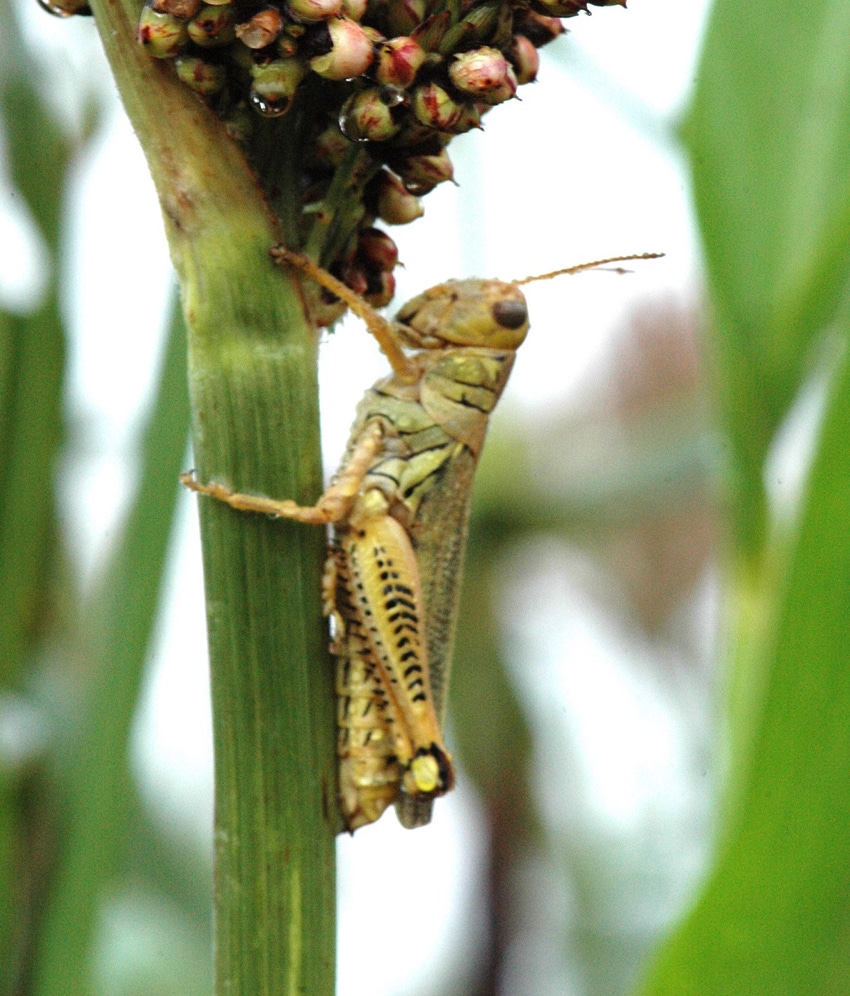
Grasshoppers and thrips may soon threaten to take a bite out of young cotton, corn and sorghum. Farmers may need to apply insecticides but certainly should monitor their fields, says Texas A&M AgriLife Extension Service specialist Dr. Ed Bynum.
Bynum, AgriLife Extension entomologist in Amarillo, says early stages of grasshoppers are emerging in the northwestern area of the Panhandle, and thrips are showing up on young cotton.
Grasshopper eggs typically begin hatching from late April through May, and peak in mid-June, but that can extend into July. Nymphs go through five or six developmental stages and become adults in 40 to 60 days, with adults living another 40 to 50 days.
“With the first nymphs emerging in early May, we can begin to see adult grasshoppers by July and continue to have adult grasshoppers well into the fall,” he says.
DIFFICULT TO CONTROL
“Unfortunately, as we have seen the last few years, controlling grasshoppers in and around fields is very difficult because of extensive numbers and widespread movement,” Bynum says. “However, as they become active, early and persistent control measures against the nymphs will help reduce adult populations later in the season.”
Numerous organophosphate, pyrethroid and other classes of insecticides are labeled for grasshopper control in field crops, such as alfalfa, corn, cotton, sorghum and soybeans. Each product is labeled for specific crops or non-cropland usage and should be consulted before use.
Bynum says the organophosphate and pyrethroid products are neurotoxins and will provide fast knockdown and kill, but they also are more harmful to beneficial insects and will cause outbreaks of spider mites.
As for thrips, Bynum says now that cotton has been planted for at least a couple of weeks, insecticide seed treatments may start losing their effectiveness.
“These insecticide seed treatments probably provide protection for 18 to 21 days from when the seeds were planted,” he says. “A sign that control is declining and no longer effective is when immature thrips are found surviving on the cotton leaves. When 30 percent of the thrips are immatures, then a foliar application is needed if numbers reach the action threshold.
“Generally, with good, warm growing conditions, the insecticide residual activity is usually sufficient to protect cotton from germination to the fifth true-leaf growth stage.”
ACTION THRESHOLD
Bynum says producers should use the action threshold for making foliar application decisions when daily maximum temperatures are above 83 degrees.
However, he adds, when cold fronts with daily maximum temperatures below 83 degrees persist for four to five days, a foliar insecticide may be required, based on a modified action threshold by dividing each true leaf threshold in half.
Therefore, the action threshold for emergence to one true-leaf stage would be 0.5 thrips per plant and so forth.
Foliar applications of Orthene/Acephate and Bidrin provides about five days of protection and Dimethoate about four days of control, he says. This could require multiple foliar applications to prevent severe adult western flower thrips and larvae damage.
“It is important to control thrips before significant damage [occurs],” Bynum says. “Research has shown that if you use foliar insecticides and wait until you see damage or until you make a herbicide spray, the damage from thrips has already been done.”
About the Author(s)
You May Also Like




